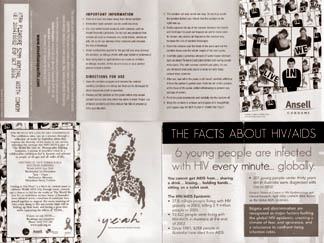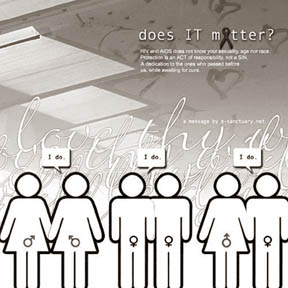|
observer |
|
|
|
|
|
OTHER LINKS |

|

|

|
STI and AIDS:Future challengesThe President of the Council of the College of Venereologists, Dr. K.A.M. Ariyaratne last week called on the medical practitioners to come out with a broader perspective to tackle the spread of sexually transmitted diseases.
ExcerptsVenereal diseases were named after the mythical goddess "Venus" and have been in existence since antiquity. During ancient times important archaeological discoveries brought to light medical artefacts, papyri and mummies that established the prevalence of STIs. The French Venereologist Philippe Ricord made the cryptic comment that the first sentence of the Bible should have been "In the beginning God created the heaven, the earth, man and venereal diseases". At present they are known as sexually transmitted infections. The literature reveals that world over the prevalence and incidence of most STIs have increased rather than decreased in both developed and developing countries. STI continues to be a major problem throughout the world and Sri Lanka is no exception. I wish to outline a few important STIs and look at the challenges for their prevention, especially in relation to Sri Lanka. 1. Syphilis In Sri Lanka, the prevalence of infectious syphilis is declining over the years but our challenge is to develop cost effective interventions targeting control and elimination of congenital syphilis. 1.2 Elimination of congenital syphilis
The building blocks for elimination of congenital syphilis is already available in Sri Lanka including policy guidelines for universal antenatal syphilis screening, high levels of antenatal attendance, low cost screening test, treatment with penicillin which is cheap. What is required is increased motivation at all levels of health service including policy makers, public healthcare providers and obstetricians to work in a coordinated manner to achieve the desired results. 2. Gonorrhoea Gonorrhoea is one of the oldest known diseases of humans. Gonorrhoea undoubtedly was known to the authors of the bible. The book of Leviticus describes a person with urethral discharge. If not adequately and correctly treated, gonorrhoea infection is not always without complications. In females, pelvic inflammatory disease can lead to fertility problems and chronic pelvic pain. In males, transurethral spread of the organism can lead to infection of the epididymis. Disseminated infections can result from prolonged untreated gonorrhoea. However, since culture facilities are at present available only in Colombo, Kandy, Kurunegala and Badulla, the challenge is to provide this facility to other peripheral areas in the future. In developed countries a variety of molecular tests are being used to detect gonococci antigen and DNA hybridization, polymerase chain reaction and ligase chain reaction tests. The high cost prevents using these tests in most of the developing countries. In Sri Lanka an extraordinary increase in the incidence of gonorrhoea has been observed since 2002. This is an important risk marker as well as a risk factor for an impending HIV epidemic. The increased incidence of gonorrhoea in spite of all our efforts at behaviour change and promotion of safe sex is a matter of great concern. We need to control and prevent gonorrhoea among high risk groups such as commercial sex workers and men who have sex with men. Penetrating into these hard to reach population groups for prevention activities is a challenge. 3. Human Papiloma Virus infection and cervical cancer Warty lesions of the ano-genital area have been described as early as the first century AD. The venereal origin of the disease was described in the 1950s. Two prophylactic vaccines both highly effective against oncogenic HPV types are now available in developed countries. Both vaccines target HPV types 16 & 18 which are responsible for 70% of cervical cancer cases worldwide. In addition to these two prophylactic vaccines a therapeutic vaccine is in the horizon. The therapeutic vaccine Lovaxin C, has entered clinical trials in March 2006. The vaccine is based on a modified, genetically engineered strain of the bacterium Listeria monocytogenes. However, because of the heterogeneity of HPV genotypes in different parts of the world, the impact of the vaccines may vary across regions. The service delivery strategy of this product in Sri Lanka will be a challenging one considering its affordability and cultural acceptability as vaccinating young girls against a cancer caused by a sexually transmitted pathogen may be a sensitive issue. 4. Genital herpes In Sri Lanka, Herpes is one of the commonest sexually transmitted diseases reported from STD clinics. Infection with Herpes Simplex Virus type 2 causes most of genital herpes infections and is responsible for almost all recurrent herpes episodes. The majority of people who are infected are asymptomatic and do not report a history of symptoms or awareness that they are infected, yet they can transmit the infection. Those with frequent recurrences may have substantial psychological and psychosexual morbidity. Widespread misconceptions about herpes infection add to the trauma of infected and affected people. Hence addressing the psychosocial and sexual morbidity through indepth counselling is a challenge to care providers. 5. HIV /AIDS In this global age the most talked about infection in the world as well as in Sri Lanka is HIV and AIDS. HIV/AIDS has now emerged as the most devastating sexually transmitted infection. Three of the earliest known instances of HIV infection are as follows: 1. A plasma sample taken in 1959 from an adult male living in what is now the Democratic Republic of Congo. 2. HIV found in tissue samples from an American teenager who died in St. Louis in 1969. 3. HIV found in tissue samples from a Norwegian sailor who died around 1976. It is estimated that 40 million people are living with HIV infection and about 3 million people die each year. Given the scale of the epidemic, AIDS is now considered not only as a health problem, but also a developmental and security threat. More than 95% of infections now occur in the developing world, which includes countries that are least equipped to effectively respond to the challenge. Currently, Sri Lanka is considered to be a country with a low prevalence of HIV. However, most of the risk behaviours that facilitate the spread of HIV exist within the country. In response to the 3 x 5 initiative of the WHO, Sri Lanka initiated the ART programme in 2004 December. As of June 2006, 85 HIV infected persons have been treated with antiretroviral therapy. With antiretroviral therapy AIDS has now been transformed into a chronic disease similar to diabetes or hypertension. The challenge is to scale up provision of ARV to cover all those who are eligible for treatment. Presence of vulnerable populations such as sex workers, drug users, men who have sex with men and, internal and external migrants potentially promote the spread of HIV. In relation to HIV AIDS I would like draw your attention to a few aspects of the presenting challenge. a. Sex industry Sex workers are rated as high frequency transmitters of sexually transmitted infections and are the reservoirs of infection. In Asia the engine of growth of the HIV infection is considered to be the sex industry. Although prostitution in Sri Lanka is illegal, it is estimated that around 30,000 women and girls are engaged in the commercial sex industry in the country. They operate in brothels, massage parlours, hotels and some are streetwalkers and call girls. Their awareness and knowledge of STI are limited due to lack of information. The available data show that 45% of female sex workers have experienced multiple STI. b. Males who have sex with males (MSM) It is estimated that 5-10% of all HIV infections in the world are transmitted by sex between males. Male to male sex occur in every culture and country and they come from all social classes. They range from men who maintain normal masculine identities and do not identify themselves as gay, to trangenders i.e. men who do not accept their gender and identify as women; like India's hijras, Indonesia's waria and Thailand's katoey. A significant proportion of men who have sex with men also have sex with women making a wider population vulnerable to HIV. However, due to widespread stigma and discrimination, MSM are less likely to utilize preventive programmes. A recent report by TREAT Asia states that prevention programmes were available to only 2 per cent of men who have sex with men in the 16 Asia-Pacific countries surveyed. c. Migration Foreign employment industry is the second largest foreign exchange earner for Sri Lanka. Internal migration for employment is a common situation in Sri Lanka. Thousands of women and men live away from their families as workers in Sri Lankan Free Trade Zones. Women constitute 80% of the workers in the Free Trade Zones. The vulnerability of these women is indicated by the reports of high rate of unwanted pregnancies and high prevalence of sexually transmitted diseases (STDs) amongst them. Migrant populations are at higher risk of contracting HIV because of the situation they face in their migration such as poverty, exploitation, and separation from families and partners. Migrant populations are often working individuals, subject to poor and unstable living and working conditions. Such conditions usually mean that they have limited access to reliable and culturally appropriate information on HIV/AIDS and to health services. d. Abuse of the Internet During the past decade, the Internet has created new opportunities for meeting sex partners. Internet users can anonymously find partners with similar sexual interests without having to leave their residence or having to risk face-to-face rejection. The Internet may also normalize certain risky behaviours by making others aware of these behaviours and creating new connections between those who engage in them. At the same time, the Internet is a potentially powerful tool for HIV prevention interventions providing necessary knowledge and skills. The subject of STI/HIV including prevention of risk behaviours need to be introduced to youth in school and out of school. It will save their lives before it is too late. |
 Delivering his Presidential Address at the Annual Scientific Session
of the Council of the College of Venereologists, Dr Ariyaratne proposed
a combined approach by the medical practitioners, legislators, social
scientists and policy makers to formulate a comprehensive social and
health strategy to mitigate the impact of STD and AIDS.
Delivering his Presidential Address at the Annual Scientific Session
of the Council of the College of Venereologists, Dr Ariyaratne proposed
a combined approach by the medical practitioners, legislators, social
scientists and policy makers to formulate a comprehensive social and
health strategy to mitigate the impact of STD and AIDS.  It is possible to eliminate congenital syphilis as a public health
problem by testing women for syphilis early in pregnancy, treating those
who are sero-positive, and preventing reinfection. Treating the mother
with a single dose of penicillin is nearly always effective in
preventing or treating infection in the foetus.
It is possible to eliminate congenital syphilis as a public health
problem by testing women for syphilis early in pregnancy, treating those
who are sero-positive, and preventing reinfection. Treating the mother
with a single dose of penicillin is nearly always effective in
preventing or treating infection in the foetus. 







